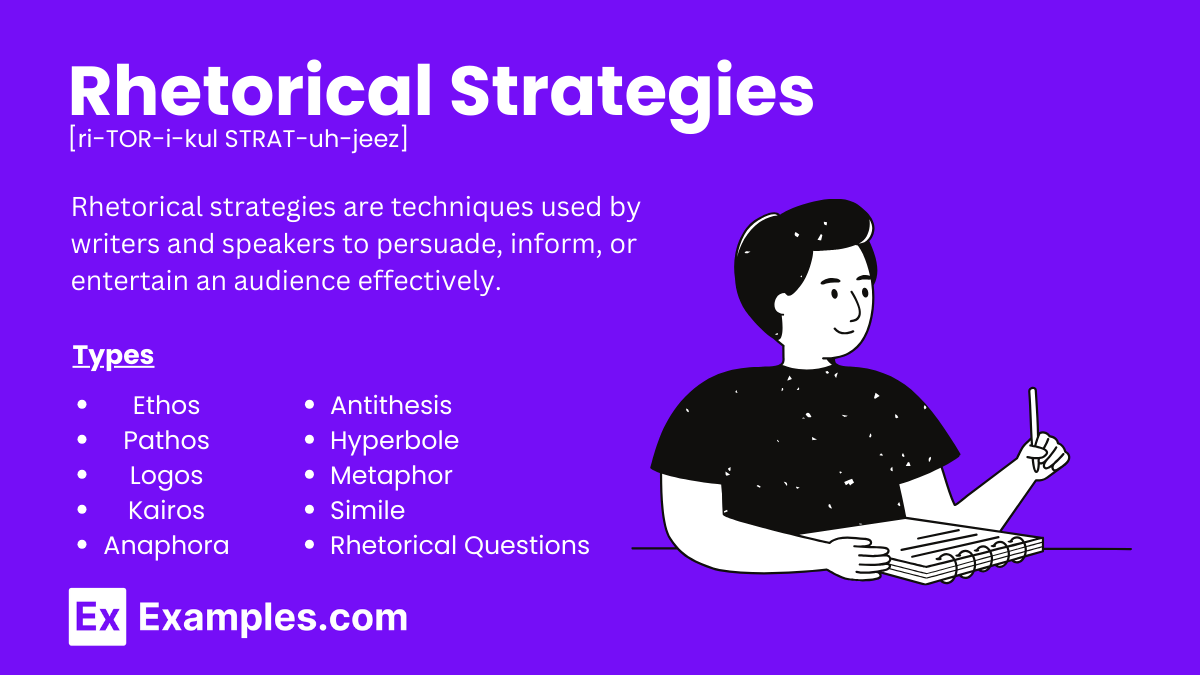60+ Rhetorical Strategy Examples
In the realm of effective communication, the art of persuasion holds immense power. Rhetorical strategies are the secret weapons wielded by skilled communicators to sway opinions, evoke emotions, and captivate audiences. Whether you’re addressing a crowd, writing a persuasive essay, or crafting a compelling brand message, understanding and employing rhetorical strategies is essential. This article delves into the world of rhetorical strategies, providing insights, examples, and a step-by-step guide to help you harness their persuasive potential.
What are Rhetorical Strategies?
Rhetorical strategies are deliberate techniques used to enhance communication and influence an audience’s perception or response. They involve skillfully using language, structure, and style to achieve specific goals, such as convincing, inspiring, or entertaining. Rhetorical strategies encompass a range of literary devices, appeals, and techniques that engage both the logical and emotional aspects of an audience’s thinking.
Types of Rhetorical Strategies
Rhetorical strategies are techniques used by writers and speakers to persuade, inform, or entertain an audience. Understanding these strategies can enhance both the creation and analysis of texts. Here are some of the most common types of rhetorical strategies:
1. Ethos
Definition: Ethos is an appeal to credibility or character. Writers and speakers use ethos to establish trust and authority with their audience.
Examples:
- Professional Titles: “As a doctor, I recommend this treatment.”
- Personal Experience: “Having taught for 20 years, I can attest to the importance of this method.”
2. Pathos
Definition: Pathos is an appeal to emotion. This strategy aims to evoke an emotional response from the audience.
Examples:
- Emotional Stories: “Imagine the pain of losing a loved one to this disease.”
- Vivid Language: “The heartbreaking scene left everyone in tears.”
3. Logos
Definition: Logos is an appeal to logic or reason. It uses facts, statistics, and logical arguments to persuade the audience.
Examples:
- Statistics: “Studies show that 90% of students improve with this technique.”
- Logical Arguments: “If we want to reduce pollution, we must adopt cleaner energy sources.”
4. Kairos
Definition: Kairos is an appeal to timeliness. It emphasizes the urgency of the argument and the need to act now.
Examples:
- Immediate Action: “We must act now before it’s too late.”
- Relevant Events: “Given the recent events, this policy is more important than ever.”
5. Anaphora
Definition: Anaphora is the repetition of a word or phrase at the beginning of successive clauses or sentences. It is used to create emphasis.
Examples:
- Speech: “We shall fight on the beaches, we shall fight on the landing grounds, we shall fight in the fields.”
- Writing: “Every day, every night, in every way, I am getting better.”
6. Antithesis
Definition: Antithesis is the juxtaposition of contrasting ideas in balanced phrases or clauses. It highlights differences to create a powerful effect.
Examples:
- Contrast: “It was the best of times, it was the worst of times.”
- Opposing Ideas: “Give me liberty, or give me death.”
7. Hyperbole
Definition: Hyperbole is the use of exaggerated statements to emphasize a point. It is not meant to be taken literally.
Examples:
- Exaggeration: “I have a million things to do today.”
- Amplification: “This is the best thing that has ever happened to me.”
8. Metaphor
Definition: A metaphor is a figure of speech that compares two unlike things without using “like” or “as”. It helps to illustrate a point more vividly.
Examples:
- Direct Comparison: “Time is a thief.”
- Implicit Comparison: “The classroom was a zoo.”
9. Simile
Definition: A simile is a figure of speech that compares two unlike things using “like” or “as”. It creates vivid imagery.
Examples:
- Direct Comparison: “Her smile was as bright as the sun.”
- Explicit Comparison: “He fought like a lion.”
10. Rhetorical Questions
Definition: Rhetorical questions are questions asked for effect, not meant to be answered. They encourage the audience to think deeply about the topic.
Examples:
- Thought-Provoking: “Isn’t it time we took a stand?”
- Reflective: “What would you do in this situation?”
11. Parallelism
Definition: Parallelism is the use of similar structures in two or more clauses. It creates rhythm and makes the message more memorable.
Examples:
- Balanced Structure: “Easy come, easy go.”
- Repetition: “Like father, like son.”
12. Anecdote
Definition: An anecdote is a short, personal story used to illustrate a point. It makes the argument more relatable and engaging.
Examples:
- Personal Story: “When I was a child, I learned the value of hard work from my father.”
- Relatable Incident: “I once met a woman who changed my perspective on this issue.”
13. Allusion
Definition: An allusion is a reference to a well-known person, event, or work. It connects the audience to broader themes and ideas.
Examples:
- Historical Reference: “This decision is as significant as the moon landing.”
- Literary Reference: “He has the strength of Hercules.”
14. Irony
Definition: Irony is the expression of one’s meaning by using language that normally signifies the opposite. It often highlights discrepancies between reality and expectations.
Examples:
- Verbal Irony: “Oh great! Another homework assignment.”
- Situational Irony: “A fire station burns down.”
Examples of Rhetorical Strategies:
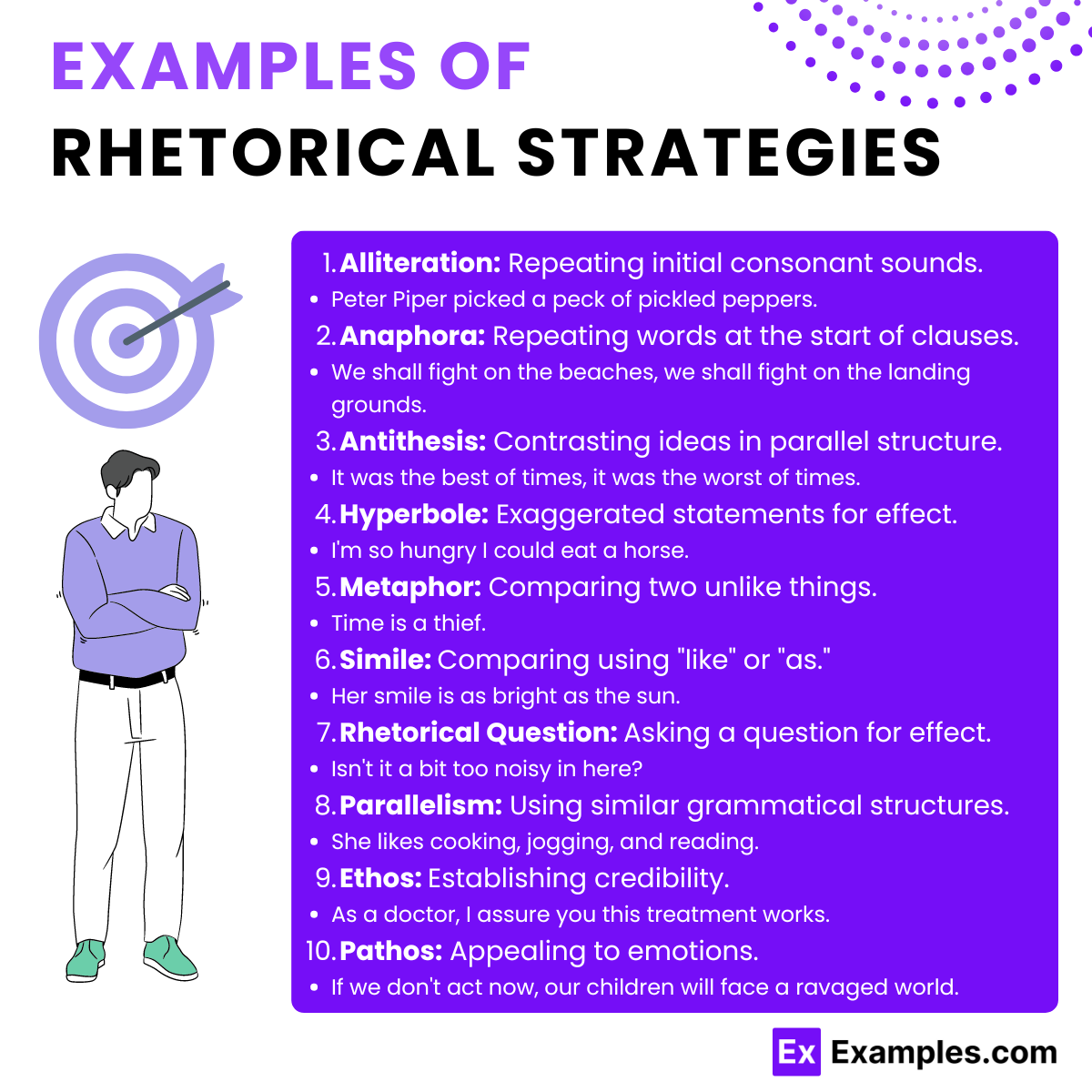
Rhetorical Strategies Examples in writing
Rhetorical strategies are essential for making writing more persuasive and impactful. Here are detailed examples of various rhetorical strategies used in writing:
1. Ethos
Ethos is an appeal to credibility or character. It helps establish the writer’s reliability and authority.
Example:
- Professional Expertise: “As a tenured professor of environmental science, I can confidently say that climate change is the most pressing issue of our time.”
2. Pathos
Pathos is an appeal to emotion. It aims to evoke feelings to persuade the audience.
Example:
- Emotional Appeal: “Imagine the despair of a family who has lost everything in a natural disaster. We must act now to provide relief and support.”
3. Logos
Logos is an appeal to logic and reason. It uses facts, statistics, and logical arguments.
Example:
- Logical Argument: “Data from the World Health Organization indicates that vaccination reduces the risk of serious illness by 95%. Therefore, increasing vaccination rates is crucial.”
4. Kairos
Kairos is an appeal to timeliness, emphasizing the urgency of an argument.
Example:
- Urgent Call to Action: “With the rise in global temperatures, now is the time to adopt sustainable practices. Waiting any longer could lead to irreversible damage.”
5. Anaphora
Anaphora is the repetition of a word or phrase at the beginning of successive clauses or sentences.
Example:
- Repetition for Emphasis: “We demand justice. We demand equality. We demand change.”
6. Antithesis
Antithesis juxtaposes contrasting ideas in balanced phrases to highlight differences.
Example:
- Contrasting Ideas: “It was the best of times, it was the worst of times.”
7. Hyperbole
Hyperbole uses exaggerated statements for emphasis, not meant to be taken literally.
Example:
- Exaggeration: “I’ve told you a million times to clean your room!”
8. Metaphor
A metaphor directly compares two unlike things without using “like” or “as”.
Example:
- Direct Comparison: “Time is a thief that steals our moments.”
9. Simile
A simile compares two unlike things using “like” or “as”.
Example:
- Explicit Comparison: “Her smile was as bright as the sun.”
10. Rhetorical Questions
Rhetorical questions are asked for effect, not to be answered, to provoke thought.
Example:
- Thought-Provoking Question: “How can we stand by and do nothing when so many are suffering?”
11. Parallelism
Parallelism uses similar structures in successive clauses or sentences for rhythm and balance.
Example:
- Balanced Structure: “She enjoys reading, writing, and skiing.”
12. Anecdote
An anecdote is a short, personal story used to illustrate a point.
Example:
- Personal Story: “When I was a child, my mother always told me that hard work pays off. Her words have guided me through every challenge I’ve faced.”
13. Allusion
An allusion references a well-known person, event, or work to connect broader themes.
Example:
- Historical Reference: “This policy could be our New Deal, bringing hope to millions in economic distress.”
14. Irony
Irony expresses meaning using language that normally signifies the opposite, often for humorous or emphatic effect.
Example:
- Verbal Irony: “Oh, fantastic! Another meeting that could have been an email.”
15. Oxymoron
Oxymoron combines contradictory terms to create a paradoxical effect.
Example:
- Contradictory Terms: “Bittersweet memories filled the room.”
16. Personification
Personification attributes human characteristics to non-human things.
Example:
- Human Traits: “The wind whispered secrets through the trees.”
17. Understatement
Understatement presents something as less significant than it is, often for ironic or humorous effect.
Example:
- Minimizing: “It’s just a small scratch,” said about a large dent in the car.
18. Synecdoche
Synecdoche uses a part to represent the whole.
Example:
- Part for Whole: “All hands on deck” means everyone must help.
19. Metonymy
Metonymy substitutes a name with something closely related to it.
Example:
- Symbolic Substitution: “The White House announced new policies today.”
20. Euphemism
Euphemism uses mild or indirect words to replace ones considered harsh or blunt.
Example:
- Mild Expression: “Passed away” instead of “died.”
21. Chiasmus
Chiasmus reverses the order of words in parallel phrases.
Example:
- Reversed Structure: “Ask not what your country can do for you—ask what you can do for your country.”
22. Polysyndeton
Polysyndeton uses multiple conjunctions in close succession to create a sense of accumulation.
Example:
- Excessive Conjunctions: “We have ships and men and money and stores.”
23. Asyndeton
Asyndeton omits conjunctions between parts of a sentence for a concise effect.
Example:
- Omitted Conjunctions: “I came, I saw, I conquered.”
24. Litotes
Litotes uses double negatives to create an understatement.
Example:
- Understatement: “He’s not unskilled,” meaning “He’s quite skilled.”
25. Epistrophe
Epistrophe repeats a word at the end of successive clauses or sentences.
Example:
- Repetition at End: “See no evil, hear no evil, speak no evil.”
Rhetorical Strategies Examples in Logos
Rhetorical Strategies Examples in Logos
Logos is a rhetorical strategy that appeals to logic and reason. It relies on factual evidence, logical arguments, and clear reasoning to persuade the audience. Here are some examples of logos in writing:
1. Use of Statistics
- Fact-Based Argument: “According to the Centers for Disease Control and Prevention, 70% of smokers want to quit, and more than 40% try to quit each year. Therefore, providing accessible smoking cessation programs can significantly reduce smoking rates.”
2. Citing Research and Studies
- Supporting Evidence: “A study published in the Journal of Medicine found that regular exercise reduces the risk of heart disease by 30%. This indicates that incorporating physical activity into daily routines is essential for maintaining cardiovascular health.”
3. Logical Deduction
- Deductive Reasoning: “All humans need water to survive. John is a human. Therefore, John needs water to survive.”
4. Analogies
- Comparative Logic: “Just as a car requires regular maintenance to function efficiently, our bodies need regular check-ups to stay healthy.”
5. Cause and Effect
- Logical Connection: “If we reduce our carbon emissions, we will slow down the rate of global warming. Hence, adopting green technologies is crucial for the environment.”
6. Historical Examples
- Past Evidence: “Historically, countries that have invested heavily in education, such as Finland and South Korea, have seen significant economic growth and social development. This demonstrates the importance of prioritizing educational funding.”
7. Definition and Clarification
- Clear Explanation: “Artificial Intelligence (AI) is the simulation of human intelligence processes by machines, especially computer systems. These processes include learning, reasoning, and self-correction. Understanding AI is crucial for navigating the future job market.”
8. Facts and Data
- Empirical Evidence: “The Earth orbits the Sun at an average distance of about 93 million miles. This distance is known as an astronomical unit and is used to measure distances within our solar system.”
9. Expert Testimony
- Credible Source: “Dr. Jane Smith, a renowned epidemiologist, stated in her recent publication that widespread vaccination could lead to herd immunity, significantly reducing the spread of infectious diseases.”
10. Comparisons
- Comparative Analysis: “The literacy rate in Country A is 95%, whereas in Country B, it is only 60%. This stark difference highlights the impact of government investment in education.”
11. Statistics in Arguments
- Quantitative Data: “In 2020, renewable energy sources accounted for 20% of the total energy consumption in the United States, showing a steady increase from 15% in 2015.”
12. Graphical Evidence
- Visual Data: “The graph below shows the correlation between increased physical activity and lower rates of chronic diseases, reinforcing the importance of an active lifestyle.”
13. Logical Sequencing
- Step-by-Step Reasoning: “To solve the problem of traffic congestion, we must first improve public transportation infrastructure. This will encourage more people to use public transit, reducing the number of cars on the road and, consequently, traffic jams.”
14. Specific Examples
- Concrete Illustrations: “Consider the case of Country X, where the implementation of renewable energy policies led to a 25% reduction in carbon emissions within five years.”
15. Use of Facts
- Factual Statement: “Water boils at 100 degrees Celsius at sea level. This physical property is essential for various scientific and culinary applications.”
Rhetorical Strategies Examples in Pathos
Pathos is a rhetorical strategy that appeals to the audience’s emotions. It aims to evoke feelings such as sympathy, anger, joy, or sadness to persuade the audience. Here are some examples of pathos in writing:
1. Emotional Stories
- Heartfelt Narrative: “Little Timmy’s eyes welled up with tears as he watched his home burn down. The flames consumed not just his house, but all the memories and dreams his family had built.”
2. Vivid Descriptions
- Imagery: “The stench of decaying garbage filled the air, and the sight of emaciated children scavenging for food was a heart-wrenching reminder of the poverty that grips this community.”
3. Appeals to Fear
- Scary Scenario: “Imagine a world where clean drinking water is a luxury only the rich can afford. This could be our reality if we don’t act now to conserve our water resources.”
4. Appeals to Compassion
- Compassionate Plea: “Every night, thousands of homeless people sleep on the cold, hard streets. We must do something to provide them with the shelter and care they deserve.”
5. Appeals to Hope
- Hopeful Vision: “Together, we can create a future where no child goes to bed hungry, where every individual has the opportunity to thrive. Let’s build a world of hope and prosperity for all.”
6. Appeals to Anger
- Inciting Anger: “It’s infuriating that big corporations continue to pollute our rivers with toxic waste, showing complete disregard for our health and the environment.”
7. Personal Anecdotes
- Relatable Story: “When I lost my job, I felt like my world was falling apart. But with the support of my community, I was able to find new opportunities and rebuild my life.”
8. Use of Strong Language
- Powerful Words: “The government’s inaction in the face of this crisis is not just disappointing; it’s an outright betrayal of the public trust.”
9. Appeals to Pride
- Encouraging Pride: “We are a nation built on resilience and determination. It’s time to rise to the challenge and prove that we can overcome any obstacle.”
10. Appeals to Sadness
- Tragic Events: “The sight of the orphaned children, with no one to comfort them, was enough to bring tears to even the most stoic observer.”
11. Use of Metaphors and Similes
- Comparative Emotion: “Her smile was like a ray of sunshine on a stormy day, bringing warmth and hope to those around her.”
12. Appeals to Nostalgia
- Nostalgic Reflection: “Remember the days when we could play outside without fear, when our communities were safe and close-knit? Let’s work together to bring back those times.”
13. Appeals to Love
- Expressions of Love: “Our love for our children drives us to fight for a better world, a world where they can grow up happy, healthy, and free from harm.”
14. Appeals to Guilt
- Guilt Trip: “How can we enjoy our comfortable lives while knowing that millions of people are suffering in poverty? We have a moral obligation to help.”
15. Appeals to Joy
- Joyful Scenarios: “Imagine the joy of a mother who finally receives news that her child, lost in the chaos of war, has been found safe and sound.”
16. Appeals to Patriotism
- National Pride: “As citizens of this great nation, it is our duty to uphold the values of freedom and justice that our forefathers fought so hard to protect.”
17. Evocative Language
- Emotion-Laden Words: “The brutal reality of war leaves scars that never heal, haunting the souls of those who endure its horrors.”
18. Appeals to Justice
- Justice Appeal: “It’s time we stood up against the injustices faced by marginalized communities and fought for a fair and equitable society.”
19. Appeals to Family Values
- Family Focus: “Think about the future we want to leave for our children and grandchildren. Let’s make choices that reflect our commitment to their well-being.”
20. Appeals to Unity
- Call for Unity: “In times of crisis, we must come together as one community, united by our shared humanity and determination to overcome adversity.”
Rhetorical Strategies Examples in Literature
Rhetorical strategies are powerful tools used by authors to enhance their writing, convey their messages effectively, and evoke emotions in readers. Here are examples of various rhetorical strategies found in literature:
1. Ethos
- “To Kill a Mockingbird” by Harper Lee: Atticus Finch establishes his credibility and moral authority as he defends Tom Robinson, emphasizing his principles and ethical stance.
- Quote: “You never really understand a person until you consider things from his point of view… Until you climb inside of his skin and walk around in it.”
2. Pathos
- “The Grapes of Wrath” by John Steinbeck: Steinbeck evokes deep empathy for the suffering of migrant families during the Great Depression.
- Quote: “How can you frighten a man whose hunger is not only in his own cramped stomach but in the wretched bellies of his children?”
3. Logos
- “1984” by George Orwell: Orwell uses logical arguments and statistical data to illustrate the oppressive nature of totalitarian regimes.
- Quote: “War is peace. Freedom is slavery. Ignorance is strength.”
4. Kairos
- “The Iliad” by Homer: The concept of timeliness is central as Homer highlights the urgency of Achilles’ actions and decisions in the context of the Trojan War.
- Quote: “Sing, O goddess, the anger of Achilles son of Peleus, that brought countless ills upon the Achaeans.”
5. Anaphora
- “A Tale of Two Cities” by Charles Dickens: Dickens uses anaphora to create rhythm and emphasize the dualities in his opening passage.
- Quote: “It was the best of times, it was the worst of times, it was the age of wisdom, it was the age of foolishness…”
6. Antithesis
- “Julius Caesar” by William Shakespeare: Shakespeare uses antithesis in Brutus’ speech to highlight the conflicting emotions and rationales behind Caesar’s assassination.
- Quote: “Not that I loved Caesar less, but that I loved Rome more.”
7. Hyperbole
- “The Adventures of Pinocchio” by Carlo Collodi: Hyperbole is used to exaggerate Pinocchio’s mischief and the consequences he faces.
- Quote: “I have a heart as big as an ox, and it’s almost ready to burst with joy!”
8. Metaphor
- “The Road Not Taken” by Robert Frost: Frost uses metaphor to compare life choices to diverging roads.
- Quote: “Two roads diverged in a wood, and I—I took the one less traveled by, And that has made all the difference.”
9. Simile
- “The Great Gatsby” by F. Scott Fitzgerald: Fitzgerald uses simile to describe the protagonist’s feelings and experiences.
- Quote: “In his blue gardens men and girls came and went like moths among the whisperings and the champagne and the stars.”
10. Rhetorical Questions
- “The Love Song of J. Alfred Prufrock” by T.S. Eliot: Eliot employs rhetorical questions to reflect the protagonist’s indecisiveness and inner turmoil.
- Quote: “Do I dare / Disturb the universe?”
11. Parallelism
- “I Have a Dream” by Martin Luther King Jr.: King uses parallelism to emphasize his vision for equality and justice.
- Quote: “I have a dream that one day this nation will rise up and live out the true meaning of its creed: ‘We hold these truths to be self-evident, that all men are created equal.'”
12. Anecdote
- “To Kill a Mockingbird” by Harper Lee: Lee uses anecdotes to provide background and context for characters and events, enhancing the narrative.
- Quote: “When he was nearly thirteen, my brother Jem got his arm badly broken at the elbow.”
13. Allusion
- “Moby-Dick” by Herman Melville: Melville alludes to biblical and mythological figures to add depth to his characters and themes.
- Quote: “Call me Ishmael.”
14. Irony
- “Pride and Prejudice” by Jane Austen: Austen uses irony to critique social norms and character flaws.
- Quote: “It is a truth universally acknowledged, that a single man in possession of a good fortune, must be in want of a wife.”
15. Oxymoron
- “Romeo and Juliet” by William Shakespeare: Shakespeare uses oxymorons to express conflicting emotions.
- Quote: “O brawling love, O loving hate.”
16. Personification
- “The Wind in the Willows” by Kenneth Grahame: Grahame personifies animals, giving them human traits and emotions.
- Quote: “The Mole had been working very hard all the morning, spring-cleaning his little home.”
17. Understatement
- “The Catcher in the Rye” by J.D. Salinger: Salinger uses understatement to reflect Holden Caulfield’s cynical and jaded view of the world.
- Quote: “I have to have this operation. It isn’t very serious. I have this tiny little tumor on the brain.”
18. Synecdoche
- “The Love Song of J. Alfred Prufrock” by T.S. Eliot: Eliot uses synecdoche to emphasize parts of the whole to create a sense of fragmentation.
- Quote: “I should have been a pair of ragged claws / Scuttling across the floors of silent seas.”
19. Metonymy
- “The Sun Also Rises” by Ernest Hemingway: Hemingway uses metonymy to depict the disillusionment of the Lost Generation.
- Quote: “The pen is mightier than the sword.”
20. Euphemism
- “Of Mice and Men” by John Steinbeck: Steinbeck uses euphemism to soften the harsh reality of euthanasia.
- Quote: “He ain’t no good to you, Candy. An’ he ain’t no good to himself. Why’n’t you shoot him, Candy?”
21. Chiasmus
- “Paradise Lost” by John Milton: Milton uses chiasmus to create a memorable and impactful statement.
- Quote: “Fair is foul, and foul is fair.”
22. Polysyndeton
- “The Things They Carried” by Tim O’Brien: O’Brien uses polysyndeton to convey the overwhelming burden carried by soldiers.
- Quote: “They carried backpacks, and helmets, and rifles, and grenades, and…”
23. Asyndeton
- “Julius Caesar” by William Shakespeare: Shakespeare uses asyndeton to convey urgency and intensity.
- Quote: “Are all thy conquests, glories, triumphs, spoils, Shrunk to this little measure?”
24. Litotes
- “Beowulf”: The epic uses litotes to convey understatement and modesty.
- Quote: “That was no small feat.”
25. Epistrophe
- “The Gettysburg Address” by Abraham Lincoln: Lincoln uses epistrophe to emphasize unity and dedication.
- Quote: “Government of the people, by the people, for the people, shall not perish from the earth.”
Rhetorical Strategies Examples Sentences
Rhetorical strategies are powerful tools that can enhance writing and make arguments more compelling. Here are examples of sentences employing various rhetorical strategies:
1. Ethos
- “As a renowned climate scientist, I can assure you that the data supports the urgent need for action on climate change.”
2. Pathos
- “Think of the children who go to bed hungry every night, their stomachs aching and their dreams filled with despair.”
3. Logos
- “Studies show that people who exercise regularly are 50% less likely to develop heart disease.”
4. Kairos
- “Now, more than ever, we must come together to address the pressing issue of climate change before it’s too late.”
5. Anaphora
- “We shall fight on the beaches, we shall fight on the landing grounds, we shall fight in the fields and in the streets.”
6. Antithesis
- “It was the best of times, it was the worst of times.”
7. Hyperbole
- “I’ve told you a million times to clean your room!”
8. Metaphor
- “Time is a thief that steals our moments.”
9. Simile
- “Her smile was as bright as the sun.”
10. Rhetorical Questions
- “How can we ignore the suffering of so many people?”
11. Parallelism
- “She likes cooking, jogging, and reading.”
12. Anecdote
- “When I was a child, my mother always told me that hard work pays off.”
13. Allusion
- “This new policy could be our generation’s New Deal.”
14. Irony
- “A fire station burning down.”
15. Oxymoron
- “The silence was deafening.”
16. Personification
- “The wind whispered secrets through the trees.”
17. Understatement
- “It’s just a scratch,” he said, referring to the large dent in his car.
18. Synecdoche
- “All hands on deck.”
19. Metonymy
- “The White House issued a statement.”
20. Euphemism
- “He passed away last night.”
21. Chiasmus
- “Never let a Fool Kiss You or a Kiss Fool You.”
22. Polysyndeton
- “We have ships and men and money and stores.”
23. Asyndeton
- “I came, I saw, I conquered.”
24. Litotes
- “He’s not the worst singer.”
25. Epistrophe
- “When I was a child, I spoke as a child, I understood as a child, I thought as a child.”
More Rhetorical Strategies Examples & Samples:
1. Rhetorical Analysis of Rhetorical Strategies
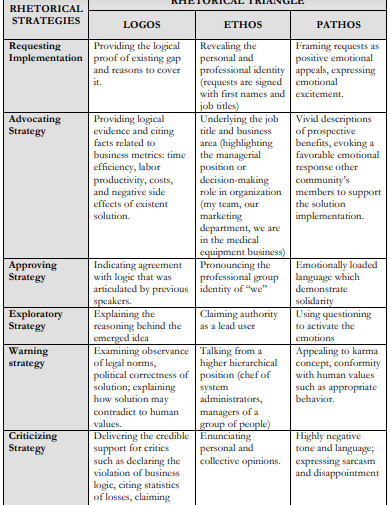
diva-portal.org
2. Rhetorical Strategies Example

ccsoh.us
3. Rhetorical Strategies Questions Example
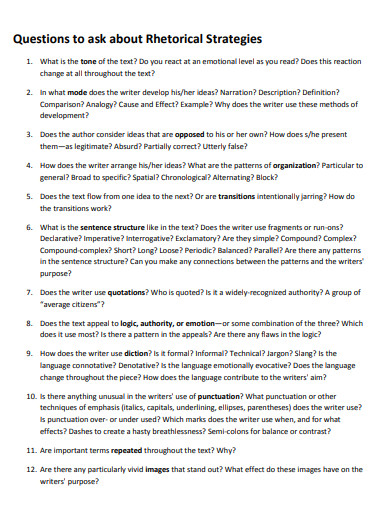
lsu.edu
4. Rhetorical Strategies Template
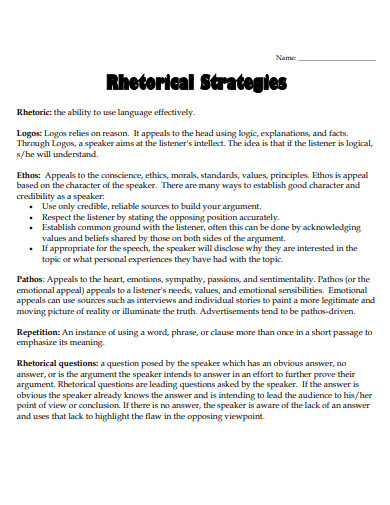
cusd80.com
5. Rhetorical Strategies for Essays Example
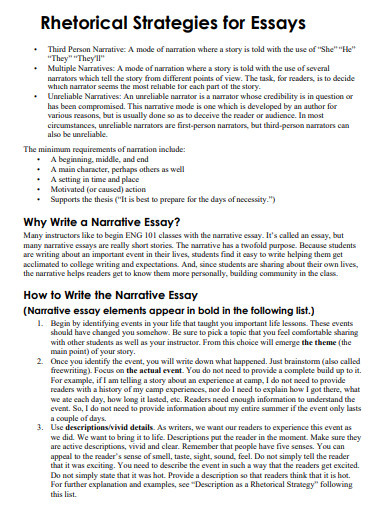
pvccenglish.files.wordpress.com
6. Simple Rhetorical Strategies Example
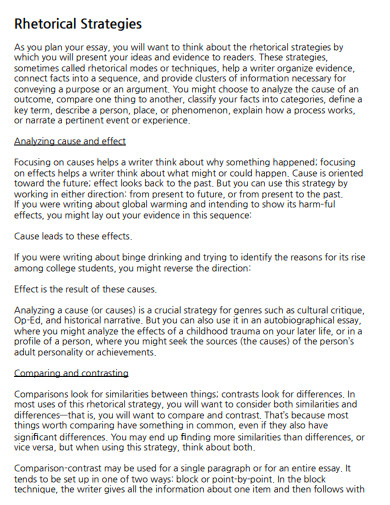
thelearninglog.weebly.com
7. Hiring and Recruitment Rhetorical Strategies Example
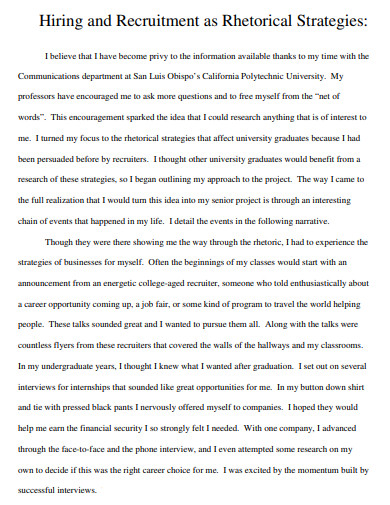
digitalcommons.calpoly.edu
8. Rhetorical Strategies Abstract Example

kuscholarworks.ku.edu
9. Rhetorical Strategies Writing Example
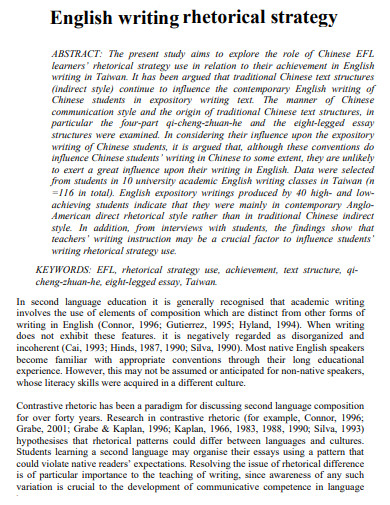
files.eric.ed.gov
Rhetorical Strategies vs. Rhetorical Devices
| Aspect | Rhetorical Strategies | Rhetorical Devices |
|---|---|---|
| Definition | Broad techniques used to shape arguments and persuade audiences | Specific tools or techniques used to enhance the expression within the strategies |
| Purpose | To structure and develop the overall argument and appeals effectively | To add emphasis, clarity, vividness, and variety to the language used in the arguments |
| Scope | General approaches encompassing the overall method of persuasion | Specific figures of speech or stylistic choices used within the broader strategies |
| Examples | Ethos, Pathos, Logos, Kairos | Metaphor, Simile, Anaphora, Hyperbole |
How to use Rhetorical Strategies
From captivating speeches to compelling advertisements, mastering rhetorical strategies can elevate your communication prowess. Let’s explore a step-by-step guide to effectively employing rhetorical strategies.
Step 1: Understand Your Audience and Purpose
Before embarking on the journey of persuasion, delve into understanding your audience and the context in which you’ll communicate. Define your purpose—whether it’s to inform, persuade, or entertain—and tailor your rhetorical strategies to align with your goals. Context is key; consider how different rhetorical strategies might resonate with your intended audience.
Step 2: Employ Persuasive Appeals
Rhetorical strategies often involve three primary persuasive appeals: ethos, pathos, and logos. Ethos establishes credibility and authority, pathos evokes emotions, and logos appeals to logic and reason. Incorporate these appeals strategically to build a well-rounded argument essay or message that resonates with your audience’s sensibilities.
Step 3: Utilize Literary Devices
Enhance your communication with literary devices such as metaphors, similes, alliteration, and imagery. These elements add depth and vividness to your words, making your message more memorable and impactful. For instance, in a persuasive essay on environmental conservation, you could use vivid imagery to describe the dire consequences of neglecting our planet.
Step 4: Craft Compelling Examples and Analogies
Examples and analogies are powerful tools that help clarify complex concepts and create relatable connections. Just as a case study demonstrates the real-world application of a scientific method, crafting analogies can simplify intricate ideas and make them accessible to a wider audience.
What are rhetorical strategies?
Rhetorical strategies are techniques used by writers and speakers to persuade, inform, or entertain an audience through effective communication.
What is the difference between ethos, pathos, and logos?
Ethos appeals to credibility, pathos appeals to emotion, and logos appeals to logic and reason.
How do rhetorical strategies enhance writing?
They add depth, clarity, and persuasiveness, making arguments more compelling and engaging for the audience.
What is an example of ethos in writing?
“As a tenured professor, I assure you this research is credible.”
Why is pathos important in rhetoric?
Pathos evokes emotions, helping to connect with the audience on a personal level and make arguments more compelling.
How can logos be effectively used in arguments?
By presenting clear, logical evidence and reasoning, such as statistics and facts, to support a claim.
What is the role of kairos in rhetoric?
Kairos emphasizes the timeliness and urgency of an argument, making it relevant and immediate.
Can you give an example of a rhetorical question?
“Isn’t it time we took a stand against injustice?”
What is anaphora and why is it used?
Anaphora is the repetition of a word or phrase at the beginning of successive clauses, used to create emphasis and rhythm.
How do rhetorical strategies differ from rhetorical devices?
Strategies are broader techniques for persuasion, while devices are specific tools like metaphors or similes used within those strategies.



